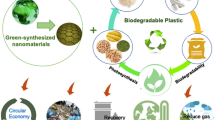Abstract
By incorporating organic-inorganic nano-hybridization into wet phase inversion coating-forming method, a novel antimicrobial polyurethane synthetic leather coating with in-situ generated nano-TiO2 (PUT) was prepared. The antibacterial activity against Staphylococcus aureus, Escherichia coli, Pseudomonas aeruginosa, Micrococcus luteus, antifungal activity against Aspergillus niger and toxicity of this PUT coating were investigated respectively. Experimental results showed that the antimicrobial activity of the PUT coating increased with increasing nano-TiO2 concentration. Low nano-TiO2 concentration (≤0.50 wt%) resulted in negligible or limited antimicrobial activity. When the nano-TiO2 concentration increased up to 0.75 and 1.00 wt%, the antibacterial activity of the PUT coating exceeded 82 and 93 % respectively, and no Aspergillus niger growth was observed on the coating surface within 28 days. Cell culture assay indicated that the PUT coating had no detrimental effect on the morphologies and proliferation rate of normal human dermal fibroblasts, which indicated a non-toxic and skin-friendly characteristic. According to these results, the PUT coating was capable of reducing the risk of microbial contamination while remained skin-friendly to wearers. More importantly, the organic-inorganic nano-hybridization technique developed in this study was carried out simultaneously during the established wet phase inversion coating-forming method for PU leather manufacture, which promised its possible application on an industrial scale.
Similar content being viewed by others
References
P. L. Xu and S. Q. Zhang, “Handbook of Polyurethane Materials”, Chemical Industry Press, Beijing, 2002.
R. Jayakumar, Y. S. Lee, and S. Nanjundan, J. Appl. Polym. Sci., 92, 710 (2004).
Z. H. Zhang, G. M. Wu, J. Shen, T. Fu, F. Yang, C. S. Xia, and J. Wang, J. Mater. Sci. Eng., 21, 498 (2003).
J. M. Niu and C. Z. Yu, China Leather, 32, 35 (2003).
S. X. Li and L. M. Zhu, “Polyurethane Resin”, Jiangsu Science Press, Nanjing, 1992.
S. S. Ding, F. R. Wang, and Z. M. Wang, “Man-made Leather and Synthetic Leather”, Sinopec-Press, Beijing, 1997.
J. L. Lv, “Antimicrobial Techniques for Light Industry Products”, Chemical Industry Press, Beijing, 2003.
T. Matsunaga, R. Tomoda, T. Nakajima, and H. Wake, FEMS Microbiol. Lett., 29, 211 (1985).
L. L. Xu, X. F. Qi, and Y. Q. Chen, Shandong Ceramics, 30, 26 (2007).
J. M. C. Robertson, P. K. J. Robertson, and L. A. Lawton, J. Photochem. Photobio., A, 175, 51 (2005).
Y. Chen, H. J. Fan, Z. Y. Li, H. H. Shi, and B. Shi, Proceedings of 2007 National Conference on Leather Chemicals, China: Xi’an, pp.426, October, 2007.
Y. Chen, X. L. Zhang, H. J. Fan, and B. Shi, J. Am. Leather Chem.Assoc., 104, 210 (2009).
Z. H. Shan, “Chemistry and Processes of Leather Making”, Science Press, Beijing, 2005.
S. H. Lim and S. M. Hudson, Carbohydr. Polym., 56, 227 (2004).
Z. Huang, P. C. Maness, D. M. Blake, E. J. Wolfrum, S. L. Smolinski, and W. A. Jacoby, J. Photochem. Photobio., A, 130, 163 (2000).
O. Carp, C. L. Huisman, and A. Reller, Prog. Solid State Chem., 32, 33 (2004).
K. M. S. Khalil and M. I. Zaki, Powder Technol., 92, 233 (1997).
C. Randorn, S. Wongnawa, and P. Boonsin, Science Asia, 30, 149 (2004).
Z. Zhang and P. A. Maggard, J. Photochem. Photobio., A, 186, 8 (2007).
B. Ohtani, Y. Ogawa, and S. Nishimoto, J. Phys. Chem. B, 101, 3746 (1997).
M. Kanna and S. Wongnawa, Mater. Chem. Phys., 110, 166 (2008).
J. F. Ruan, C. X. Li, and Z. H. Wang, Journal of Beijing University of Chemical Technology, 29, 1 (2002).
Author information
Authors and Affiliations
Corresponding author
Rights and permissions
About this article
Cite this article
Chen, Y., Yan, L., Wang, R. et al. Antimicrobial polyurethane synthetic leather coating with In-situ generated Nano-TiO2 . Fibers Polym 11, 689–694 (2010). https://doi.org/10.1007/s12221-010-0689-1
Received:
Revised:
Accepted:
Published:
Issue Date:
DOI: https://doi.org/10.1007/s12221-010-0689-1




